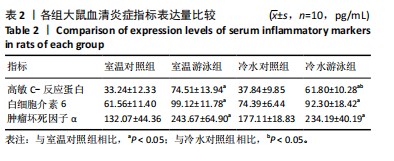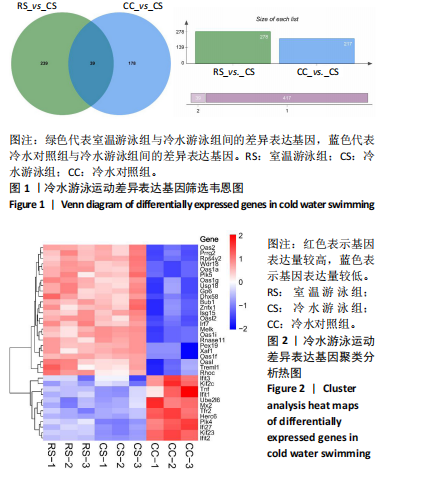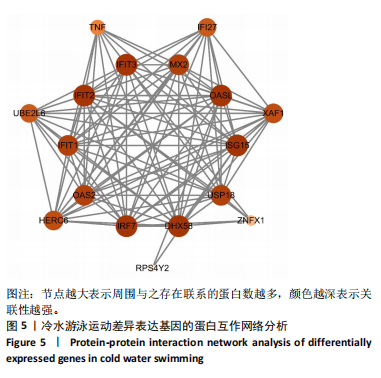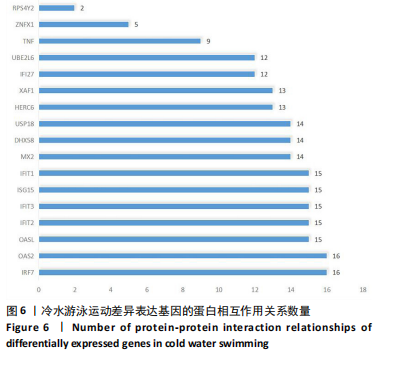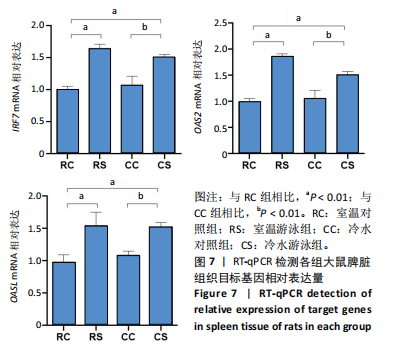[1] CHADDA KR, PUTHUCHEARY Z. Persistent inflammation, immunosuppression, and catabolism syndrome (PICS): a review of definitions, potential therapies, and research priorities. Br J Anaesth. 2024;132(3):507-518.
[2] 魏伟. 炎症免疫反应软调节:药物研究新方向(英文)[J]. 中国药理学与毒理学杂志,2017,31(10):942-943.
[3] 陶瑀, 谢颖, 刘秀娟. 不同运动对肥胖大鼠机体免疫和炎症反应的影响[J]. 中国体育科技,2019,55(10):74-80.
[4] CERQUEIRA É, MARINHO DA, NEIVA HP, et al. Inflammatory Effects of High and Moderate Intensity Exercise-A Systematic Review. Front Physiol. 2019;10:1550.
[5] 唐劲松, 宣春, 林景涛, 等. C-反应蛋白、白介素-6及降钙素原检测在新冠肺炎中的临床意义[J]. 实用医学杂志,2020,36(7):839-841.
[6] HABIBI P, AHMADIASL N, NOURAZARIAN A, et al. Swimming exercise improves SIRT1, NF-κB, and IL-1β protein levels and pancreatic tissue injury in ovariectomized diabetic rats. Horm Mol Biol Clin Investig. 2022;43(3):345-352.
[7] DA SILVA LA, THIRUPATHI A, COLARES MC, et al. The effectiveness of treadmill and swimming exercise in an animal model of osteoarthritis. Front Physiol. 2023;14:1101159.
[8] 宋燕娟, 马春莲, 丁海超, 等. 中等强度游泳运动调控PPARγ/NF-κB/ADPN通路对2型糖尿病大鼠肝脏糖脂代谢紊乱的影响[J]. 中国康复医学杂志,2024,39(5):618-627+633.
[9] COLLIER N, LOMAX M, HARPER M, et al. Habitual cold-water swimming and upper respiratory tract infection. Rhinology. 2021;59(5):485-487.
[10] GIBAS-DORNA M, CHĘCIŃSKA Z, KOREK E, et al. Cold Water Swimming Beneficially Modulates Insulin Sensitivity in Middle-Aged Individuals. J Aging Phys Act. 2016;24(4):547-554.
[11] CHECINSKA-MACIEJEWSKA Z, MILLER-KASPRZAK E, CHECINSKA A, et al. Gender-related effect of cold water swimming on the seasonal changes in lipid profile, ApoB/ApoA-I ratio, and homocysteine concentration in cold water swimmers. J Physiol Pharmacol. 2017;68(6):887-896.
[12] DHABHAR FS. Effects of stress on immune function: the good, the bad, and the beautiful. Immunol Res. 2014;58(2-3):193-210.
[13] SHATTOCK MJ, TIPTON MJ. ‘Autonomic conflict’: a different way to die during cold water immersion? J Physiol. 2012;590(14):3219-3230.
[14] HOHMANN E, GLATT V, TETSWORTH K. Swimming induced pulmonary oedema in athletes - a systematic review and best evidence synthesis. BMC Sports Sci Med Rehabil. 2018;10:18.
[15] STJEPANOVIC M, NIKOLAIDIS PT, KNECHTLE B. Swimming Three Ice Miles within Fifteen Hours. Chin J Physiol. 2017;60(4):197-206.
[16] 潘新亮, 赵晨曦, 陈健豪, 等. 运动科学中的多组学应用前景:运动组学[J]. 北京体育大学学报,2023,46(11):52-63.
[17] HSIEH YL, YANG NP, CHEN SF, et al. Early Intervention of Cold-Water Swimming on Functional Recovery and Spinal Pain Modulation Following Brachial Plexus Avulsion in Rats. Int J Mol Sci. 2022;23(3): 1178.
[18] DA SILVA JT, CELLA PS, TESTA MTJ, et al. Mild-cold water swimming does not exacerbate white adipose tissue browning and brown adipose tissue activation in mice. J Physiol Biochem. 2020;76(4):663-672.
[19] EN LI CHO E, ANG CZ, QUEK J, et al. Global prevalence of non-alcoholic fatty liver disease in type 2 diabetes mellitus: an updated systematic review and meta-analysis. Gut. 2023;72(11):2138-2148.
[20] RIKSEN NP, BEKKERING S, MULDER WJM, et al. Trained immunity in atherosclerotic cardiovascular disease. Nat Rev Cardiol. 2023;20(12): 799-811.
[21] LY M, YU GZ, MIAN A, et al. Neuroinflammation: A Modifiable Pathway Linking Obesity, Alzheimer’s disease, and Depression. Am J Geriatr Psychiatry. 2023;31(10):853-866.
[22] LUO B, XIANG D, JI X, et al. The anti-inflammatory effects of exercise on autoimmune diseases: A 20-year systematic review. J Sport Health Sci. 2024;13(3):353-367.
[23] 史东林, 杨贤罡. 运动员的冷环境暴露:风险因素、症状和应对策略[J]. 北京体育大学学报,2021,44(12):147-155.
[24] SUGIMOTO S, MENA HA, SANSBURY BE, et al. Brown adipose tissue-derived MaR2 contributes to cold-induced resolution of inflammation. Nat Metab. 2022;4(6):775-790.
[25] LIU J, WU J, QIAO C, et al. Impact of chronic cold exposure on lung inflammation, pyroptosis and oxidative stress in mice. Int Immunopharmacol. 2023;115:109590.
[26] 刘萌萌, 张紫薇, 袁建彬, 等. 冷暴露对小鼠回肠机械屏障的影响及其机制[J]. 中国应用生理学杂志,2022,38(3):279-283.
[27] 吴佳琦, 包雨鑫, 王梓, 等. 冷应激对科尔沁牛和科尔沁肉牛免疫功能的影响[J]. 畜牧与兽医,2021,53(12):49-52.
[28] GHOLAMNEZHAD Z, SAFARIAN B, ESPARHAM A, et al. The modulatory effects of exercise on lipopolysaccharide-induced lung inflammation and injury: A systemic review. Life Sci. 2022;293:120306.
[29] ZHANG Y, XU J, ZHOU D, et al. Swimming exercise ameliorates insulin resistance and nonalcoholic fatty liver by negatively regulating PPARγ transcriptional network in mice fed high fat diet. Mol Med. 2023;29(1): 150.
[30] 李章春, 孙海波, 秦萍, 等. 游泳运动对慢性非细菌性前列腺炎大鼠p38MAPK/NF-κB信号通路的影响[J]. 医学理论与实践,2024, 37(13):2165-2167+2180.
[31] ALLEN J, SUN Y, WOODS JA. Exercise and the Regulation of Inflammatory Responses. J Prog Mol Biol Transl Sci. 2015;135:337-354.
[32] ALMURAIKHY S, DOUDIN A, DOMLING A, et al. Molecular regulators of exercise-mediated insulin sensitivity in non-obese individuals. J Cell Mol Med. 2024;28(1):e18015.
[33] SMITH LL. Cytokine hypothesis of overtraining: a physiological adaptation to excessive stress? Med Sci Sports Exerc. 2000;32(2): 317-331.
[34] LIN W, SONG H, SHEN J, et al. Functional role of skeletal muscle-derived interleukin-6 and its effects on lipid metabolism. Front Physiol. 2023; 14:1110926.
[35] JIANG S, BAE JH, WANG Y, et al. The Potential Roles of Myokines in Adipose Tissue Metabolism with Exercise and Cold Exposure. Int J Mol Sci. 2022;23(19):11523.
[36] MARTINS GA, DEGEN AN, ANTUNES FTT, et al. Benefits of electroacupuncture and a swimming association when compared with isolated protocols in an osteoarthritis model. J Tradit Complement Med. 2022;12(4):375-383.
[37] BOSIACKI M, TARNOWSKI M, MISIAKIEWICZ-HAS K, et al. The Effect of Cold-Water Swimming on Energy Metabolism, Dynamics, and Mitochondrial Biogenesis in the Muscles of Aging Rats. Int J Mol Sci. 2024;25(7):4055.
[38] 王寅彪, 冯继伟, 陈礼朋, 等. 2′-5′寡聚腺苷酸合成酶的抗病毒作用及机制研究进展[J]. 新乡医学院学报,2021,38(5):485-487.
[39] LIU M, ZHANG Y, YAN J, et al. Aerobic exercise alleviates ventilator-induced lung injury by inhibiting NLRP3 inflammasome activation. BMC Anesthesiol. 2022;22(1):369.
[40] XU Z, MA Z, ZHAO X, et al. Aerobic exercise mitigates high-fat diet-induced cardiac dysfunction, pyroptosis, and inflammation by inhibiting STING-NLRP3 signaling pathway. Mol Cell Biochem. 2024;479(12): 3459-3470.
[41] 耿元文, 林琴琴, 李若明, 等. 一次性力竭运动模型促进大鼠肾脏NOD样受体蛋白3炎性小体的表达[J]. 中国组织工程研究,2022, 26(2):190-196.
[42] 高晴, 鱼文欢, 何佳静, 等. 核苷酸结合寡聚化结构域样受体蛋白3炎症小体在PCOS中的研究进展[J]. 生殖医学杂志,2022,31(3): 420-424. |
